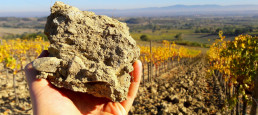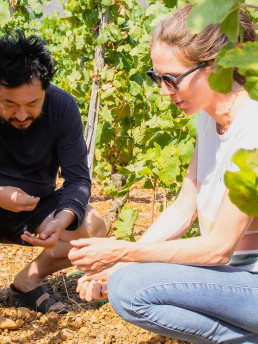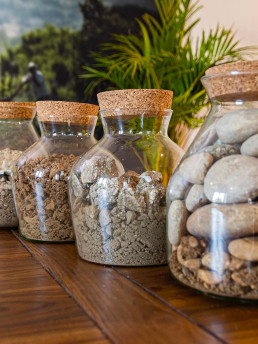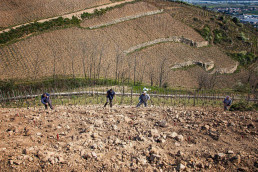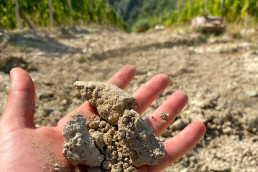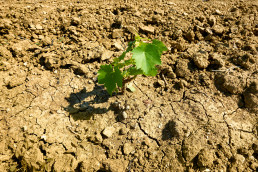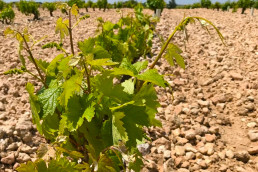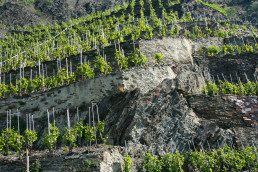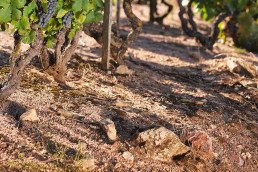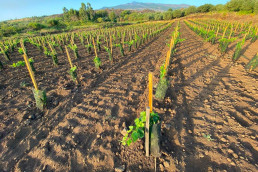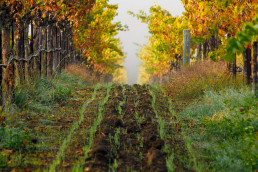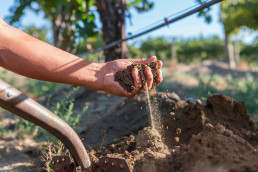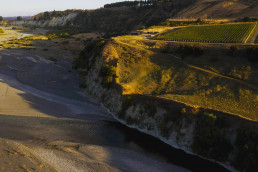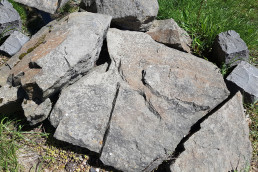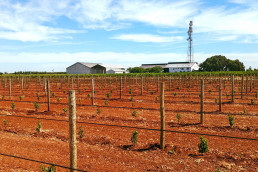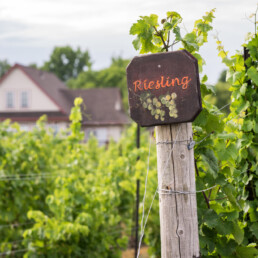Do you dig dirt? In the vineyard sense that is. Well, wine geeks and soil nerds read on… actually, anyone who loves a drop of intrigue in their wine for that matter, because we at Dhall and Nash want to Focus On a long-standing question: what role does soil play in the way a final wine tastes? And that discussion will mean, we’ll deep dive into some seriously dry soil analysis.
Geologists argue that the rocks under a vineyard can have minimal influence on how a wine tastes. Yet wine aficionados and wine lovers worldwide with the help of viticulturists, vignerons and microbiologists are providing an explanation of the links between what’s in the glass and what’s under the vine.
“You have touched on an age-old wine question and the answer is that we still don’t really know: if by ‘the soil’ you also mean the geology beneath as well as the topsoil, then the equation becomes more interesting. I think soil certainly affects wine.” – Acclaimed wine critic Jasper Morris MW
So Why Should We Give A ‘Schist’ About Soils’ Impact On Wine?
Well, as any avid gardener will attest, various garden flowers, shrubs, and vegetables perform better in one soil type as opposed to another, so too do different grape varieties. On the most basic level, soil is important to vines because it sustains their life. Soil is the primary source of food and water for vines, which help nourish the future fruit destined for vinification and our tasting pleasure.
Amazingly, soils also regulate climatic influences on vines: temperature, rainfall, and more. For example, soils (gravels, silex, flint, schist) can retain heat and release it back to plants at night, which is crucial in cooler climate areas. Soil also plays a role in dictating water levels within vineyards. Although rainfall is obviously a factor, soil determines the amount of water drained and/or retained within the earth.
Soil also provides basic nutrients (carbon, oxygen, and other elements) to vines. Over time, weathered soils dissolve these nutrients (in the humus) and continue to enrich vines, which allow growers to cultivate the same crops year after year. Even viticulture’s most rocky and ‘dirt-free’ looking soils contain humus around the roots, which assure that vines get the nutrition to regenerate after harvest. Unlike other annual crops that have shallow root systems, grape vines have deep root systems. This means that the composition of the deeper soil layers is very important for vine health and wine character.
Although it may seem unlikely or insignificant to some, the composition and texture of the dirt in which vines grow plays a serious part in what is translated into the bottle. The quest for individual vineyard expression is now celebrated by winemakers far and wide.
“All over the world winemakers are obsessed with terroir, with the way geography can shape how the produce of a particular plot of vines can taste” – Jancis Robinson MW
Of course, you can’t talk about vineyard dirt without mentioning the frequently used word ‘terroir’ which has reached almost mystical dimensions. It was once acknowledged only by the French, but today it is of international interest. English has loose equivalents for the concept. Its most basic meaning is that wine is primarily the product of climate, soil, and environment. The proper drainage and aspect to the sun, among other factors, is also required for winegrowing endeavours to succeed. Particularly now in the New World wine regions, wine producers are celebrating their unique terroir by meticulously mapping the geological makeup of each microsite within vineyards. Soil remains a critical component of terroir.
“Coming from the New World with no AOC (Appellation classification) system, we’re still discovering what happens where. Wines from different places should taste different…” – Rajat Parr, Sommelier & Winemaker
Breaking down this topic, its effects on wine, and the countless types of soil that exist worldwide can be a beast of a subject, though one thing’s for sure, if you love good vino, you should definitely give a ‘schist’!
Probably the most relevant point of departure must be noted that using only singular categories is quite difficult as most vineyard soils are not homogenous, not even close! Rather, they are often a blend of several different types, and both the rocks within and the texture of the topsoil strongly influence that region’s wines. But, in terms of the actual successful growth of a grapevine, some soils work better for certain varieties than others. Now, let’s get our hands dirty!
Mixing Up The Dirt:
Interestingly, a lot of famous wines come from clay or limestone soils often mixed with other types. For example, in Rioja and Ribera del Duero, Spain the highest quality Tempranillo vineyards grow on limestone-rich clay soils. In Burgundy, Vosne-Romanée is noted for producing the world’s most acclaimed Pinot Noir on clay-limestone soil called Marl. In Chianti, the Albarese soil is a clay-limestone soil known for making bold Sangiovese wines. Silex is a flint and sand-based soil type found primarily in the eastern Loire Valley that is formed from a mixture of clay, limestone, and silica. In the New World also, many hillside vineyards in Napa and the great Shiraz vineyards of Barossa are mostly found on clay-loam soils. And the list of mixed soil types goes on.
But wait, let’s dig some more: to look at the ‘King’ of blends – Kimmeridgian Marl is probably the most famous layer of limestone marl on the planet and it’s only found in Europe from the White Cliffs of Dover, through Sancerre to Chablis and Champagne. It is a mix of limestone and clay made eons ago in the Jurassic Age. The legend of the Kimmeridgian has assumed epic proportions in wine circles. Exalted as the bedrock and soil source of many exceptional wines, so the mere suggestion of Kimmeridgian origins brings knowing nods from wine devotees. Also, there’s Portlandian and Oxfordian limestone, which has larger pieces of gravel mixed through due to erosion over the centuries and the Oxfordian soil tends to be downslope from Kimmeridgian Marl vineyards.
To learn more about the mysterious effect of soils on wine, let’s do a little geological digging of the wine world’s main soil types…
Main Soil Types:
Limestone:
This may be considered the “bling-iest” of all soils – why – because some of the world’s most sought-after wines are made with grapes grown in limestone or chalk soils. Or with limestone in the mix, as above. Limestone soils are naturally alkaline with high pH levels that can reflect sunlight to promote photosynthesis. These soils tend to be neutral shades of white, grey, or beige, and have ancient origins. After water receded from now-dry Jurassic seabeds over 200 million years ago, an array of fossilised shells, coral and other debris accumulated to form calcified sediments. Those remains give limestone its distinctive chemical makeup, called calcium carbonate.
The calcium carbonate content is extremely beneficial for vines. First, it offers incredible water retention capabilities while simultaneously permitting excellent drainage. Secondly, calcium rich limestone soils tend to have a higher pH than other soils, which translates to easier nutrient absorption and higher acidity levels in fruit that aids age-ability in the wines. Third, the high calcium content in limestone also helps berries fight off diseases. When calcium content in soils is low, grapes begin to prioritize their inner health rather than skin health, which in turn, makes clusters more susceptible to disease and rot.
All of this to say, fruit grown in limestone soils generally has bright acidity and solid structure, which then lead to wines of serious age worthy potential (hello, Burgundy!)
Regions with limestone soil: Chablis, Champagne & Burgundy; Jura, the Loire (Sancerre, Pouilly), and Rhône Valleys in France; Jerez in Spain; Tuscany, Sardinia, Veneto, and other smaller pockets in Italy; Mendoza in Argentina; and Paso Robles in California. The seam runs across the English Channel to Southern England – note the surge in quality Methode Traditionnelle like our own Digby wines from Sussex!
Grapes that love it: Pinot Noir, Sauvignon Blanc, Chardonnay, Chenin Blanc, Soave, Vermentino
Dhall and Nash wines from this soil type: Domaine Testut Vieilles Vignes Chablis, Billecart-Samon Champagne, Vincent Carême Vouvray & many more!
The Vintner’s Version: talking to legendary Hawke’s Bay winemaker, Tony Prichard, of De la Terre Winery, gives us an interesting insight into his bit of dirt: “What gives the difference is the variation in slope and contour”, explains Tony, “and, also the ratio of limestone to topsoil, and even the amount of limestone. These three factors have a huge influence on the flavour of the wine.” A perfect example of that would be his De La Terre Viognier, which Tony thinks tastes more like a sleek Chenin Blanc than Viognier because of these unique limestone soils.
Sand:
Sandy soils are characterised by tiny particles of weathered rocks that retain heat. They are well-draining soils are ideal for vines grown in wet climates. But for regions with drought, sandy soils can be problematic.
A wine grown in warm climatic region is softer with less colour, lighter acidity, and tannin. Whereas in a cooler region, sandy soils hold heat and drain well to produce highly aromatic wines. A benefit of sandy soils is that the dreaded phylloxera louse cannot survive in them, meaning that some of the world’s oldest vines are rooted into sand (Australia). Both Cabernet Franc and Cabernet Sauvignon have a fetish for sand because it instigates deep and strong roots. Sandy soil also results in less tannin in wine, so those guys will turn out smoother.
Sandstone is a sedimentary soil composed of sand particles that has been pressured bound by various iron-based minerals. This is the main soil type of Kitterlé in Alsace.
Regions with sandy soil: Barossa, Barolo, Piedmont, Bordeaux (generally Left Bank), and parts of Graves, Chile (Maipo), and California (Lodi, Santa Barbara).
Grapes that love it: Shiraz, Mouvedre, Nebbiolo, Zinfandel, Cabernet Sauvignon & Franc, Sauvignon Blanc, Petite Sirah
Dhall and Nash wine from this soil type: Josetta Saffirio Barolo DOCG (sand, silt, clay blend)
Clay:
Clay is reeeeally finely grained, mineral-rich natural rock with organic matter and metal oxides. Because it’s so finely grained, and it swells when its wet, clay soils are known for their serious retention capabilities (both for nutrients and water). In extreme weather conditions, the tendency of the soil to remain cooler increases which greatly benefits the grape vines. In warmer climates, clay soils retain moisture. Many experts deem that wines produced from fruit grown in clay soils lead to bold, boisterous, and round final wines. The Right Bank of Bordeaux (think Pomerol and Saint-Emilion,) are known for their clay-heavy soils. These soils are excellent for grape varieties that need less hang time on the vines, like Merlot.
Chianti’s Alberese soil is a Marl whose limestone is from fossilised diatoms like Spain’s Albariza but it’s darker, less chalky, and more compact and rockier. We think you can totally taste clay in Chianti’s Sangiovese, but it does seem to be a characteristic of the varietal overall.
Regions with clay soil: Barossa Valley, Pomerol, Saint-Emilion, Chianti
Grapes that love it: Sangiovese, Merlot, Shiraz, Grenache
Dhall and Nash wine from this soil type: San Felice Chianti Classico DOCG
Fun fact: Thanks to the particularity of tectonic movement at the Alsace juncture of the Black Forest and the Vosges mountains, Alsace lays claim to a total of 800 different terroirs, as compared to Burgundy’s meagre 60!
Gravel:
Gravel-based soils (like sand) refers to the texture of the particles in the dirt. Gravelly soils are made up of rocky material, sized from quarter-sized pebbles to clunky stones. These particular types of rocks, no matter the size, retain heat and reflect them back to vines at night, allowing fruit to optimally mature. Because of this, wines from these soils tend to be bold and higher in alcohol.
Wine regions with gravel: Hawkes Bay NZ, Left Bank Bordeaux, Graves and Sauternes, Cháteauneuf-du-Pape, Piedmont, Friuli.
Grapes that love it: Cabernet Sauvignon, Chardonnay, Semillon, Viognier, Cabernet Franc
Dhall and Nash wine from this soil type: Domaine de Noiré Soif de Tendresse (Gravel, clay, sand).
Slate and Schist:
Slate is a plate-like rock formed when shale, clay, or siltstone is subjected to pressure deep within the earth. This soil type retains heat well and warms up relatively quickly. Slate comes in a variety of colours and absorbs heat, which is beneficial in cooler climate regions. Fruit grown in slate soils tends to create highly aromatic wines marked by flinty notes. Germany’s Mosel region is regarded for its heat-retaining blue and red slate soils.
Schist soils are comprised of hard, dense rocks that are layered with minerals. These soils are generally flaky, retain heat well, and create some of the world’s biggest and boldest reds. According to accomplished geologist Professor Alex Maltman, the difference between these two rocks is determined by ‘planar aspect.’ If individual minerals that comprise the rock are not visible but the splits along their secondary planes are distinct, the rock is called slate; if the minerals that comprise the rock are visible and less-marked by a clean split, the rock is called schist.
Regions with slate/schist soils: Slate is the most commonly found in the Mosel region. Portugal’s Douro Valley and Priorat are two major regions that are regarded for their schist soils.
Grapes that love it: Tempranillo, Riesling, Touriga Nacional, Grenache, Carignan
Dhall and Nash wine from this soil type: Schloss Lieser Feinherb Riesling
Granite:
Granite is a soil type composed of cooled quartz and magma. It is found all over the world and comes in a variety of textures and compositions. Granite tends to have a high pH level and rather porous make-up, which creates high-acid fruit and allows vines to dig deep into the earth. The soil’s high level of acidity works to minimize the acid levels in the grapes which works well with grapes like Gamay or Albarino.
Regions with granitic soils: The Northern Rhône, Beaujolais, Rías Baixas, Alsace
Grapes that love it: Syrah, Grenache, Gamay Noir, Mencia, Albarino, Riesling
Dhall and Nash wines from this soil type: Maior de Mendoza Albarino, Chateau des Jacques Beaujolais
Volcanic:
The most ‘hipster’ soil type of them all – totally on trend nowadays. Yet, It does seem a little nuts to make wine on the slopes of an active volcano. After all, Sicily’s Mount Etna just erupted a few weeks ago, and four times in the past 10 years. Oh, but these volcanic soils! They seem to impart a distinctive character to wine, both red and white, not found in other places. Water drains through volcanic soil easily – the soil also isn’t usually very fertile but is high in mineral content. The result tends to be smaller, higher-acid, less effusively ripe fruit, producing taut, savoury wines, concentrated in flavour but rarely heavy or dense.
When certain conditions are fulfilled then the magic comes to the glass. Minerality “liquefied” – more on this later…
Regions with volcanic soil: Sicily, Santorini Greece, Canary Islands, Soave & Campania, Italy, the Azores, Portugal. In addition, parts of Washington State, Lake County, California and Somlo, Hungary
Grapes that love it: Assyrtiko, Nerello Mascalese, Aglianico, Cataratto, Furmint
Dhall and Nash wine from this soil type: Frank Cornelissen Wines, Mt. Etna
Loam:
Like sand, silt, clay, and gravel, loam is also a soil type defined by texture. Loam is often too fertile unless it’s blended. Ideally, a crumbly mix of sand, silt, and clay as well as an organic matter (humus). When naturally occurring and blended with other soils in the right amounts it offers the ideal soil type for grape growing. This is because the clay in loam drains well but contains a moderate amount of water and nutrients and generally lies within the preferred pH range. Loam is very fertile and typically causes vineyards to be over vigorous. Because of the vigour, some loam soils produce wines that may lack deep flavours. Despite this, loam soils offer great potential with wines made from vineyards that have rigorous pruning regimes. The sand element keeps the soil poor enough to produce high quality wine grapes.
Regions with loam soil: Sonoma Valley, Napa Valley, Washington state, many pockets worldwide
Grapes that love it: Cabernets, Pinot Noir, Chardonnay
Dhall and Nash wine from this soil type: Spottswoode ‘Lydenhurst’ Cabernet sauvignon (Loam, Alluvial, clay)
Silt and Loess:
A silt soil has a finer texture than sand and is moderately porous. It has a good water retention property which is due to the small particles of soil, but this can also result in waterlogging, which can lead to vineyard disease. The wines are smooth and round with lesser acidity. In cooler climate regions that have sun, the ideal silt soil sites tend to be mixed with a portion of limestone. Although some silt soils can be too fertile for quality winemaking, Loess is one good variety, which is a wind-blown type of silt with high proportions of silica.
Regions with silt soil: Oregon, Walla Walla Valley, Washington, Central Otago, NZ, Germany, Austria
Grapes that love it: Pinot Gris, Gruner Veltliner, Pinot Noir, Syrah, Riesling
Dhall and Nash wine from this soil type: Aurum ‘Mathilde’ Pinot Noir (glacially-derived silt, gravels & sands)
Alluvial Soils/Alluvium:
Alluvial soil is an eroded mix of soil types deposited by water and tends to be rich in nutrients and fertile. It’s basically a dried riverbed from permanently defunct rivers or streams.
You’ve pretty much got everything in alluvium: clay, silt, sand, and rock/stone from all sorts of different minerals and organic matter. It can be inconsistent in drainage but Its most cherished point is the alluvial fan, where it fans out at the bottom of a slope, because this is where gravel, sand and silt are at their highest numbers. The places where alluvium is silty or clayish is where it’s more fertile and better for other crops, but where it’s stony or sandy is where grapevines love it most.
Wine regions with alluvial soils: Left Bank Bordeaux, Napa, Marlborough, Hawke’s Bay NZ
Grapes that love it: Pinots, Chardonnay, Sauvignon Blanc, Merlot, Cabernets
Dhall and Nash wine from this soil type: Folium Vineyard Reserve Sauvignon Blanc & Pinot Noir
Digging Up Some Local Dirt:
Greywacke:
Greywacke could almost be called NZ’s national soil – that’s how common it is here. It is a drab, grey stone made up of layers of very hard, clay-based, muddy grey sandstone criss-crossed through with layers of argillite (a type of mudstone) and grains of quartz, feldspar, and other small rock and mineral fragments. Vines do well in greywacke soils. The clay-derived portion of the stone weathers into clay-based soil, which has the capacity to remain cool, retain vine nutrients, and water. The rock and mineral fragments remain behind in greywacke soil to counter the clay with coarse-grained gravel, providing aeration and drainage. And some of the rocks surface on top of the soil, absorbing and releasing heat.
Wine regions with greywacke: Marlborough, Gisborne, Canterbury, Hawkes Bay and Nelson; Russian River, California, Mosel, Ahr, Mittlerhein in Germany; parts of Barossa; Algarve, Portugal.
Terra Rossa:
Terra Rossa, meaning “Red Earth” is almost synonymous with South Australia. This is soil that is left when all the limestone is broken down. It has increased levels of iron that turns it red. This is a clay that is an ‘ex-limestone’, because limestone without calcium, well, isn’t limestone. In places that have the combination of a Mediterranean climate and heavy rainfall, limestone soils can have its calcium dissolved. What’s left is an iron-rich clay devoid of calcium, and the iron oxidizes to turn the clay into a rusty reddish colour. Remember iron-rich soil makes a structured and tannic wine.
Wine regions with terra rossa – Australia’s Coonawarra makes some killer Cabernet Sauvignon and Shiraz on its Terra Rossa soil. Slovenia, Northern Italy, and Spain’s La Mancha too.
The Minerality Myth... Or Is It?
The debate goes on – that nebulous quality of minerality in wines. Minerality is a complex subject and is frequently used as a trendy descriptor. The geologists, those scientists and naysayers believe that minerality is only a concept and not something that you really taste.
“…minerality cannot literally be the taste of the soil, of the rocks and their minerals, because vines are very selective regarding which positively charged elements they take up. These elements are called ‘cations’, and they’re made up of certain metals – potassium, calcium, magnesium, and iodine. These are the nutrients that the vine needs in order to grow.” – Dr Alex Maltman, Emeritus Professor of Earth Sciences at Aberystwyth University, in Wales.
Scientists have shown that minerals in the soil do not transfer to the vines or fruit, and many (although not all) scientists use that fact to berate wine writers who use the term to describe wine. But although the fact that soil characteristics are not transferred to the wine is an interesting scientific claim, it is irrelevant to the question of whether the term “minerality” is a useful or accurate descriptor – it should perhaps be seen as a wine metaphor.
For many of us, the taste of so-called minerality in wine is a catch-all term for any of or a combination of tastes, textures, or palate experiences. This includes characteristics such as stone- or pebble-like, crushed seashells, seaweed, chalky, flinty, saline and brightness, or an energy to the acidity. It’s not merely an increase in the acidity as such but rather a quality or character of the acidity. It is clear from tasting notes and our discussions that many, many wines have these features, and they are highly prized among wine lovers, critics, and winemakers – so, we still insist minerality is a thing!
Meanwhile, from a source that you’d least expect to sit on the fence – in an Institute of Masters of Wine (IMW) seminar on Mineralogy debunked a persistent myth about minerality, saying “it is not related directly to any sort of nutrient mineral uptake by vines – even though people do perceive minerality to exist in wine.” Sally Easton M.W.
Although winemaking can be a precise science, it also relies on a measure of ‘magical’ mysteries, accidents, and artistry. How certain elements—barrel choice, fermentation, and the ripeness of grapes when they are picked, among other things—produce particular effects is fairly well understood, but, sometimes, characteristics still emerge without clear antecedents.
Dr Jamie Goode, a plant biologist and wine writer who is the author of “The Science of Wine: From Vine to Glass,” an oenological reference text, has this perspective:
“Experienced tasters can detect the influence that limestone, or schist, or granite has on the flavour of a wine… You can detect something of the soil type when you have trained yourself to listen to its voice.” – Dr Jamie Goode
Goode explains that the existing science was inadequate, and that there might be undiscovered biochemical processes at work. Still, since there isn’t yet enough research, he adds that minerality could also be thought of, for the time being, as metaphorical, akin to the notes of cherry you might find in a Pinot Noir, or buttered toast in a Chardonnay. “Language is a tool that allows us to interrogate wines,” Goode said. “The journey from the perception to the word is fraught, but I like the word ‘minerality,’ because I know what it is when I taste it.” Bravo!
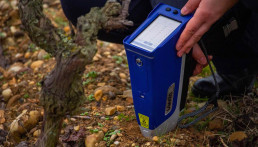
Perhaps we’ll never get to the bottom of this most indefinable of wine concepts – minerality. Maybe we should just chalk it up (pun intended) to being best considered as among the ever-expanding collection of other obscurely related terms used to define the myriad sensations, we all love to write and talk about, endlessly, devotedly, in our relationship with wine.
Let’s leave the last word on ‘minerality’ to the esteemed wine writer Jancis Robinson MW, when she wrote in “The Oxford Companion to Wine,” that the word was “too prevalent to ignore—even if impossible to define.”
